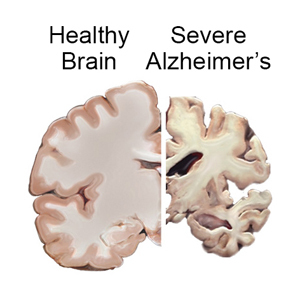What is Alzheimer’s Disease?
Scientists continue to unravel the complex brain changes involved in the onset and progression of Alzheimer’s disease. It seems likely that damage to the brain starts a decade or more before memory and other cognitive problems appear. During this preclinical stage of Alzheimer’s disease, people seem to be symptom-free, but toxic changes are taking place in the brain. Abnormal deposits of proteins form amyloid plaques and tau tangles throughout the brain, and once-healthy neurons stop functioning, lose connections with other neurons, and die.
The damage initially appears to take place in the hippocampus, the part of the brain essential in forming memories. As more neurons die, additional parts of the brain are affected, and they begin to shrink. By the final stage of Alzheimer’s, damage is widespread, and brain tissue has shrunk significantly. Read more about what happens to the brain in Alzheimer’s »

How long can a person live with Alzheimer’s disease?
Alzheimer’s is a slow disease that progresses in three stages – an early, preclinical stage with no symptoms, a middle stage of mild cognitive impairment, and a final or late stage. The disease progression varies from person to person, and not everyone experiences the same symptoms. People can live anywhere from 2 to 20 years after a diagnosis, though the average is 3 to 11 years.
Alzheimer’s is currently ranked as the 6th-leading cause of death in the United States, but it is the 3rd-leading cause of death in San Diego County.
Causes of Alzheimer’s disease
Scientists don’t yet fully understand what causes Alzheimer’s disease in most people. In people with early-onset Alzheimer’s, a genetic mutation is usually the cause. Late-onset Alzheimer’s arises from a complex series of brain changes that occur over decades. The causes probably include a combination of genetic, environmental, and lifestyle factors. The importance of any one of these factors in increasing or decreasing the risk of developing Alzheimer’s may differ from person to person.
Age-related changes in the brain
One of the great mysteries of Alzheimer’s disease is why it largely strikes older adults. Research on normal brain aging is shedding light on this question. For example, scientists are learning how age-related changes in the brain may harm neurons and contribute to Alzheimer’s damage. These age-related changes include atrophy (shrinking) of certain parts of the brain, inflammation, production of unstable molecules called free radicals, and mitochondrial dysfunction (a breakdown of energy production within a cell).
Genetics
Most people with Alzheimer’s have the late-onset form of the disease, in which symptoms become apparent in their mid-60s. The apolipoprotein E (APOE) gene is involved in late-onset Alzheimer’s. This gene has several forms. One of them, APOE ε4, increases a person’s risk of developing the disease and is also associated with an earlier age of disease onset. However, carrying the APOE ε4 form of the gene does not mean that a person will definitely develop Alzheimer’s disease, and some people with no APOE ε4 may also develop the disease.
Also, scientists have identified a number of regions of interest in the genome (an organism’s complete set of DNA) that may increase a person’s risk for late-onset Alzheimer’s to varying degrees.
Early-onset Alzheimer’s occurs in people age 30 to 60 and represents less than 5 percent of all people with Alzheimer’s. Most cases are caused by an inherited change in one of three genes, resulting in a type known as early-onset familial Alzheimer’s disease, or FAD. For others, the disease appears to develop without any specific, known cause, much as it does for people with late-onset disease.
Most people with Down syndrome develop Alzheimer’s. This may be because people with Down syndrome have an extra copy of chromosome 21, which contains the gene that generates harmful amyloid.
For more about this area of research, see the Alzheimer’s Disease Genetics Fact Sheet.
Health, Environmental, and Lifestyle Factors
Research suggests that a host of factors beyond genetics may play a role in the development and course of Alzheimer’s disease. There is a great deal of interest, for example, in the relationship between cognitive decline and vascular conditions such as heart disease, stroke, and high blood pressure, as well as metabolic conditions such as diabetes and obesity. Ongoing research will help us understand whether and how reducing risk factors for these conditions may also reduce the risk of Alzheimer’s.
A nutritious diet, physical activity, social engagement, and mentally stimulating pursuits have all been associated with helping people stay healthy as they age. These factors might also help reduce the risk of cognitive decline and Alzheimer’s disease. Clinical trials are testing some of these possibilities.
Race and ethnicity can also impact someone’s risk for developing Alzheimer’s or another type of dementia. Evidence from several studies show that African Americans are about two times more likely than white Americans to have dementias, and Latinx Americans are about one and one-half times more likely than whites to have dementia. However, both African Americans and Latinx Americans are less likely to receive an official dementia diagnosis, and when they are diagnosed, it is usually in the later stages of the disease.
Concerned about memory loss or other symptoms? Call us and let us answer your questions 858.492.4400
